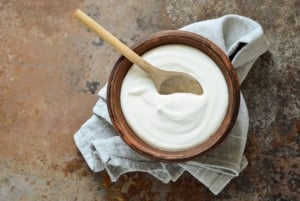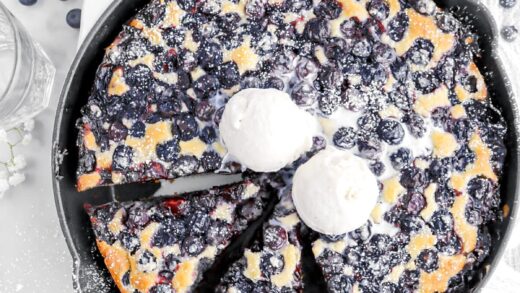
Whether added to make your cookies silky, your egg whites billowy, or your sugar syrup crystal-free, cream of tartar is an all-rounder ingredient for every kitchen. However, if you’re not a regular baker, you may find tartar powder missing from your cupboard. But don’t fret. Here you’ll find good substitutes.
Cream of tartar is a practical baking ingredient, especially if you love pie or cookie recipes like snickerdoodles. It’s also useful as a cleaning companion, removing stains and grime from your steel pans and appliances.
But what does cream of tartar exactly do in your recipes? And what are the best cream of tartar substitutes you can use?
Facts About Cream of Tartar

Facts About Cream of Tartar
You might find this surprising, but did you know the cream of tartar isn’t actually a “cream”? Yes, you read that right.
It’s common for newbie bakers to look for creamy substitutes when, in fact, cream of tartar is a dry powdery ingredient.
Technically speaking, cream of tartar is an acid (potassium bitartrate) found naturally in grapes.
It’s usually a byproduct of winemaking when the tartaric acid in the fruit comes into contact with potassium hydroxide.
As the wine ferments, the acid builds underneath the barrel, forming crusty, crystalline structures once dried.
What Is Cream of Tartar Good For?

What Is Cream of Tartar Good For?
We usually use cream of tartar as a leavening agent for baked recipes alongside baking soda. When added to cookies, cream of tartar adds that subtle tangy flavor we all love.
Mixed into the batter, the powder will make your cakes rise, creating more carbon dioxide and volume.
Soufflé and meringue pie recipes often require a pinch of cream of tartar. These desserts need a stable structure to maintain their form, and cream of tartar provides that.
Cushioning the delicate air bubbles in the egg whites, cream of tartar keeps your favorite snacks fluffy and tall.
Homemade candies like caramel and toffee also benefit from the powdery ingredient. By breaking down glucose, the cream of tartar prevents sugar crystallization that would otherwise cause your treat to become grainy. It works in icing, frosting, and syrup, as well.
Tartar powder works as a fruit preservative, too. Due to its acidic qualities, the powder inhibits bacterial growth that spoils produce. Soaking your favorite fruit and veggies in a mixture of water and cream of tartar can keep them fresh and flavorful.
Here’s a secret most newbie bakers don’t know about
Aside from its baking utilities, this white powder is also a cleaning agent. Cream of tartar helps remove tough stains from your treasured utensils. Combine tartar powder with other acids, such as vinegar and lemon juice, and you have an all-around cleaner without spending a dime.
Reasons For Seeking Cream of Tartar Substitutes

Reasons For Seeking Cream of Tartar Substitutes
You can find cream of tartar in any grocery store (typically on the spice isles) or from online baking suppliers. However, baked goods shops often don’t have it. It’s one of the reasons some bakers lack this versatile ingredient in their pantry.
Dietary Purposes
Besides being a rare commodity, you may be looking for cream of tartar alternatives for your diet. As you likely know, tartar powder provides few macronutrients but packs too much potassium. People with cases of renal disorders may want to cut some potassium.
Health Concerns
Another reason to look for a cream of tartar substitute is hyperkalemia. It’s a case of elevated potassium in the blood due to consuming too much potassium-rich diet. Hyperkalemia can affect the kidneys and is potentially life-threatening.
Chronic Conditions

Chronic Conditions
People with Addison’s disease may also want to avoid cream of tartar.
This condition affects the adrenal glands, a vital component of your endocrine system.
Consuming cream of tartar in this state can cause an imbalance in your blood’s potassium levels.
Beginner Bakers
Of course, you may be looking for substitutes simply because you didn’t know you would need tartar powder. It’s a typical rookie mistake, and we’ve all been there. Luckily, there are plenty of easy and healthier tartar powder alternatives you likely already have in your kitchen.
Best Substitutes For Cream of Tartar

Best Substitutes for Cream of Tartar
Many recipes call for a pinch of cream of tartar, from meringue cookies and meringue pies to angel food cakes.
Still, while it’s important when baking, it’s not totally irreplaceable either. If you’re halfway through your recipe and find you don’t have tartar powder, you can use the following ingredients as an excellent stand-in.
Using Baking Powder

Using Baking Powder
Did you know baking powder is just baking soda and tartar powder mixed? The cream of tartar activates the baking soda, giving your baked goods a lift without needing another acidic component.
In short, if your recipe needs both, you can use baking powder and achieve the same fluffy and flavorful cake.
However, note that baking powder is typically two parts tartar powder and one part baking soda.
So, you must keep your proportions right if you want the same velvety outcome.
For the best results, replace every teaspoon of cream of tartar with 1 1/5 teaspoons of baking powder. This proportion is ideal to prevent altering your recipe’s taste and texture.
Another thing to remember is that baking powder usually contains salt and may make your cookies somewhat saltier. It’s low in potassium (0.8 mg) but contains more sodium (363 mg).
People with heart and blood pressure problems should opt for another cream of tartar alternatives.
Using Corn Syrup

Using Corn Syrup
If you only use cream of tartar to control crystallization in your sweets recipes, then corn syrup would be your best option. Found in most baking stores, corn syrup is an excellent “interfering agent.” It can help make your sugar syrups smoother and avoid a gritty mess.
Homemade candies often need corn syrup to stop sugar crystals. Whether you’re cooking butterscotch, toffees, brittles, or candy canes, adding corn syrup would make a smoother caramel.
You can also use it to make your pecan pie fillings gooey or your cookies chewy.
Here’s a pro tip when using corn syrup: When substituting tartar powder, replace 1/4 of the sugar from your recipe with corn syrup. Then, clean your pots thoroughly to remove residues the sugar molecules can clump on. While making your candy syrup, avoid stirring or shaking the pot too much to prevent crystallization.
Using White Vinegar

Using White Vinegar
Most bakers won’t recommend replacing dry ingredients with liquids when baking to avoid altering the texture.
But with no cream of tartar in sight, vinegar can still work in a pinch. You just want to use it correctly in your recipe.
Use an equal amount of vinegar for recipes calling for tartar powder. That means to add a teaspoon of vinegar for every teaspoon of cream of tartar.
Be careful not to put too much vinegar in baked goods as it can change the flavor and consistency.
Any vinegar in your kitchen should work, though we’d recommend distilled white vinegar if possible. The acidity of this type of vinegar makes it a superb alternative to tartar powder. Plus, it doesn’t affect the color or taste of your pastry as much as red or balsamic wines.
Natural Substitutes for Cream of Tartar

Natural Substitutes for Cream of Tartar
Don’t worry if you don’t have any of the abovementioned alternatives. You can still save your pastry using natural ingredients and tools in your pantry. Look for these staple items the next time you’re out of cream of tartar.
Using Lemon Juice

Using Lemon Juice
A lemon’s zesty and acidic juice can be a perfect substitute for cream of tartar. While not a leavening agent, lemon juice can stabilize egg whites and create stiff peaks for your meringue dishes. It adds a pleasant smell and taste and can work with many baking recipes.
Use a 2:1 ratio when replacing cream of tartar with lemon juice in your recipe. That’s two teaspoons for every teaspoon of tartar powder. When whipping egg whites, use 1/2 teaspoon of lemon juice for every teaspoon of egg to help make stiff peaks.
Besides firming egg foam, lemon juice can replace tartar powder when making candies to stop crystallization. It’s sour and acidic but doesn’t add a distinct flavor to your cakes and cookies. Fresh lemon juice makes a superb option for low-potassium diets as well.
Using Copper Bowls

Using Copper Bowls
While not exactly a replacement, using a copper bowl can help stabilize egg whites in your recipes. It has this effect because copper ions react with the egg protein in your meringue.
This reaction causes the foam to be firm and less likely to overheat.
So, you can skip cream of tartar altogether and still get velvety treats from your oven. The only downside to this is that copper bowls tend to be costly.
These kitchen utensils also require meticulous care as they get damaged by heat, abrasive sponges, and cleaning agents.
Gluten-Free Substitutes for Cream of Tartar

Gluten-Free Substitutes for Cream of Tartar
One in every three Americans avoid gluten products like bread, pasta, whole wheat, and packed goods. They do this for several health reasons, including autoimmune illnesses or digestive issues. If you’re one of those who prefer to steer off gluten, here are the best tartar powder substitutes you can use.
Using Plain Yogurt

Using Plain Yogurt
If you can’t handle gluten, using plain yogurt might be the answer you’re looking for. Yogurts are nothing more than fermented milk, so they’re practically gluten-free.
Produced from lactic acid bacteria, yogurts are naturally acidic and can be an easy swap for your pastry recipe.
Since yogurt is liquid, you’ll want to reduce some of your liquid to avoid a sopping cake. Add 1/2 cup of yogurt for every 1/4 teaspoon of tartar powder.
Then, remove the same amount of liquid from your recipe.
Because you need to adjust the liquids, yogurt may be best suited for baked goods. We’d also suggest thinning the yogurt with milk until you get a buttermilk-like consistency before mixing it into the batter. When shopping for yogurt, ensure to check the label for gluten content.
Using Regular Buttermilk

Using Regular Buttermilk
If you have buttermilk stashed at the back of your cupboard, it’s time to put it to good use. The creamy acidity of buttermilk blends perfectly with some recipes. It works particularly well with baked goods, including cakes, cookies, and bread.
Buttermilk contains several acids that could help enhance your baked good’s flavor. This acidity adds a tangy taste to your batter or dough, which balances the sweetness of your recipe.
More importantly, the acid activates your leavening agent, helping your pastry to rise.
However, as with yogurt, you’ll want to readjust your liquids. To avoid soaking your food, use 1/2 cup of buttermilk for each 1/4 teaspoon of tartar powder needed in the recipe. Cut the same amount from other liquids just as you did with yogurt.
Health & Practical Tips for Substituting Cream of Tartar

Health & Practical Tips for Substituting Cream of Tartar
As you now know, there are plenty of reasons people may want to replace tartar powder. It can be your diet requirements, health conditions, or you simply don’t like the tangy flavor. Whatever your reasons are, here are some expert tips you might find helpful.
Swapping Tartar Powder with Baking Powder

Swapping Tartar Powder with Baking Powder
Baking powder makes a great replacement because it contains cream of tartar. But don’t forget to take account of its baking soda contents when using it for baking.
Some recipes may not need baking soda, and you’ll unintentionally butcher your treats.
Only use baking powder in pastries that need baking soda and tartar powder.
Most importantly, be careful when measuring your ingredients. Keep track of each teaspoon of baking powder to avoid mixing too much cream of tartar or baking soda.
Substituting Tartar Powder for Nutrition

Substituting Tartar Powder for Nutrition
If you’re replacing cream of tartar for health reasons, you must understand its nutritional value. For instance, tartar powder may not be the best source of calories. It also contains no fat, protein, sugar, fiber, or macronutrients.
Potassium is a mineral abundant in tartar powder (495 mg) that helps muscles, nerves, and the heart to function well. Still, too much potassium can lead to health problems.
Hyperkalemia is a life-threatening condition due to high levels of potassium.
Buttermilk is an excellent choice because of its vitamin-rich qualities. It offers many benefits, from protecting your intestinal health to keeping your body hydrated. Buttermilk makes you feel full and can help people attempting to lose weight.
Switching Tartar Powder Because of Chronic Illnesses

Switching Tartar Powder Because of Chronic Illnesses
People with renal or kidney disorders may benefit from substituting tartar powder with white vinegar. It’s free of sodium and low in phosphorus. One ounce of this acid only has trace amounts (5 to 50 mg) of potassium.
Although natural, lemon juice contains more potassium (103 mg) than vinegar. For this reason, it may be best to avoid this alternative if you have kidney troubles. Interestingly, the citric acid of lemon and citrus fruits may help prevent kidney stones and balance urine pH.
Yogurt provides plenty of proteins, including calcium, and other essential vitamins. It contains more potassium, sodium, and phosphorus, though. People with gut problems can benefit from yogurt by boosting digestive health.
Replacing Tartar Powder with Gluten Intolerance

Replacing Tartar Powder with Gluten Intolerance
You might be eyeing yogurt as a tartar powder substitute if you’re gluten-intolerant. So, note that some yogurt brands may not be completely gluten-free.
Some manufacturers include anti-caking ingredients or add-ons that could contain gluten.
Buttermilk is another must-watch baking ingredient when replacing tartar powder. In its traditional fermented form, buttermilk doesn’t contain any gluten proteins.
That said, some commercial buttermilk brands may have gluten-filled flavorings or additives.
Read the gluten label when shopping for yogurt and buttermilk. Look under the “contains” allergen statement and search for wheat, wheat starch, or rye. Some manufacturers may add a “gluten-free” label to their packaging.
Changing Tartar Powder for Taste

Changing Tartar Powder for Taste
Before deciding which ingredients to use, consider how they’ll affect your recipe’s taste first. You might unwittingly alter your cake’s flavor and texture. While most of these alternatives offer great results, the finished product may still come out differently than you initially wanted.
White vinegar, for instance, may not be the best solution for your baking cakes. The acid works almost similar to tartar powder when leavening the batter.
The problem is it can potentially change your recipe’s taste.
Using yogurt and buttermilk requires you to modify the recipe’s liquid contents. Sure, they can add moisture and richness to your cake. But they can also completely change the flavor, owing to their potent qualities.
Can You Skip Cream of Tartar in Your Recipes?

Can You Skip Cream of Tartar in Your Recipes?
Skipping cream of tartar altogether can be easier in some recipes. You’ll usually only need small amounts of this ingredient, so it won’t drastically change the pastry.
The food may not be as fluffy as you’d hope, but there won’t be much difference in taste.
One example would be whipping egg whites and using tartar powder as a stabilizer. You can simply leave the powder out if unavailable.
The only drawback is that your meringue will lose some firmness and height.
The same goes when you’re making icing, frosting, or syrups. Most of these recipes only add cream of tartar as a precaution against crystallization. So, omitting it won’t affect the finished product if you’re careful. Besides, you can always reheat syrups to fix crystallizations.
Can You Use Baking Soda Instead of Cream of Tartar?

Can You Use Baking Soda Instead of Cream of Tartar?
Tartar powder and baking soda look the same at first glance. We use both to create baking powder as well.
However, these two ingredients work in different ways in your pastries, so you can’t use one for the other.
Baking soda is an alkaline base, while cream of tartar serves as a mild acid. The two have opposite acidity levels.
But when mixed alongside liquid, these powders would react and neutralize each other to create carbon dioxide, lifting your dough and batter.
Frequently Asked Questions (FAQs)

Frequently Asked Questions (FAQs)
If you’re new to baking, you might have questions about tartar powder. After all, it’s not a common ingredient, and you may be encountering it for the first time. Here are some frequently asked questions about cream of tartar you might find interesting.
What Does Cream of Tartar Taste Like?

What Does Cream of Tartar Taste Like?
Owing to its fruity origin, cream of tartar has an acidic flavor with a citrusy aftertaste, somewhat similar to lemon juice or vinegar.
There’s also a hint of bitterness complementing the tanginess.
Because of its distinctive taste, most recipes only require small amounts to avoid overpowering other ingredients.
Does Cream of Tartar Go Bad?
Cream of tartar has an incredibly long shelf life compared to flour or baking soda. Stored in an airtight container under cool and dry conditions, the powder can last for years, even indefinitely. Discard your cream of tartar only if you notice discolorations or a pungent smell.
Is Cream of Tartar Necessary?
While adding cream of tartar isn’t necessary for your pastries, it does serve a crucial role in their texture and consistency. Your leavening agent might not lift the batter properly without tartar powder or other acid. Don’t skip the cream of tartar if you don’t want your cake coming out flat.
Final Thoughts

Final Thoughts
There you have it. Those are the seven best cream of tartar substitutes for your pastry recipes. You can use baking powder, corn syrup, and white vinegar.
Swap with lemon juice or use copper bowls if you prefer a more natural approach.
People with gluten issues can opt for yogurt and buttermilk for a safer and tastier treat. With small adjustments, you can create the perfect baked goods without ever needing tartar powder.
Try these easy alternatives whenever you’re in a pinch.
Other interesting articles
#Easy #Cream #Tartar #Substitutes #Practical #Baking #Tips




